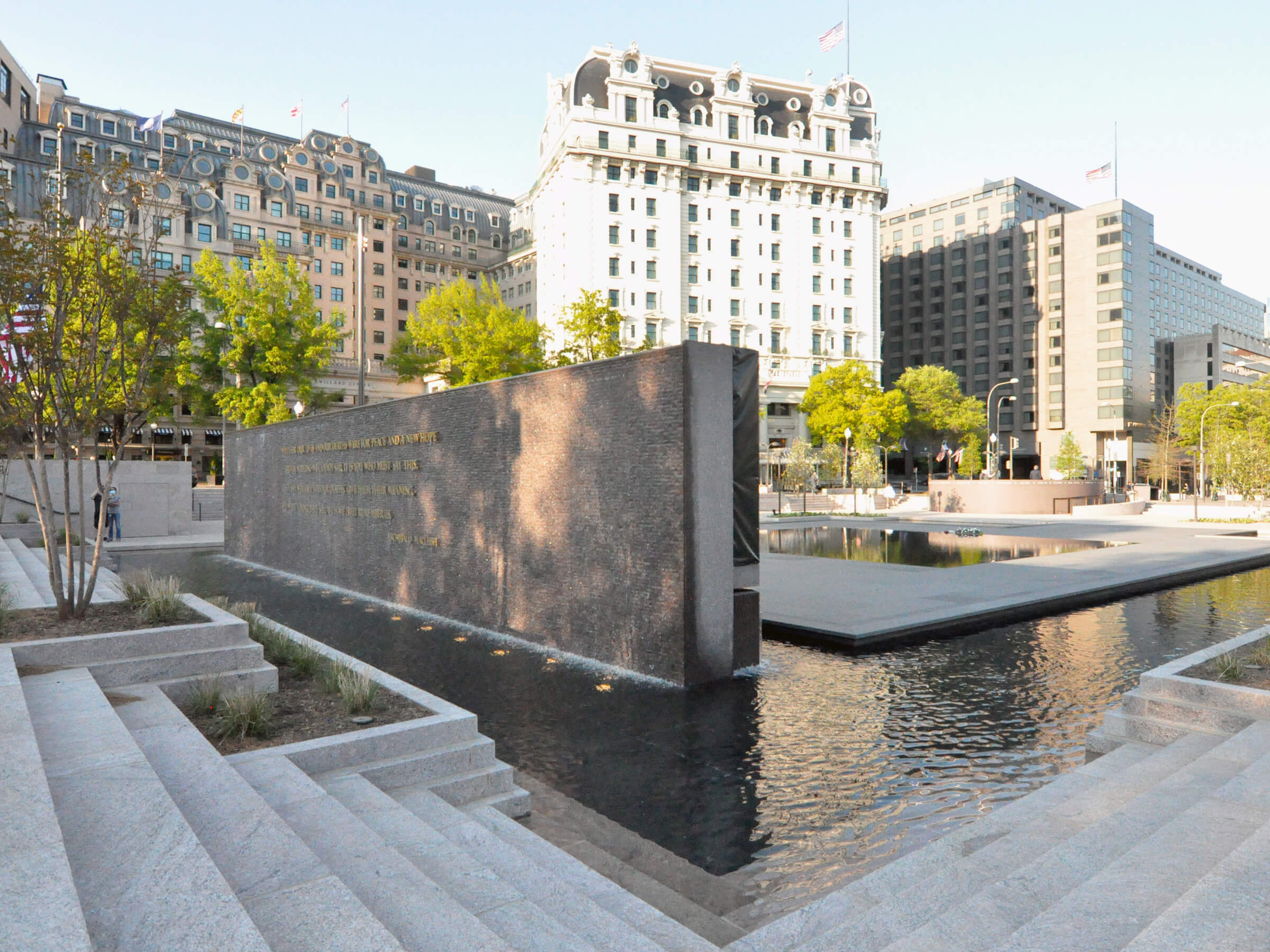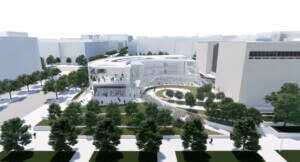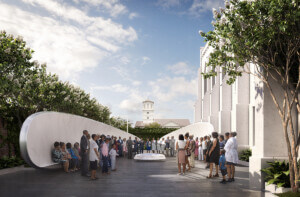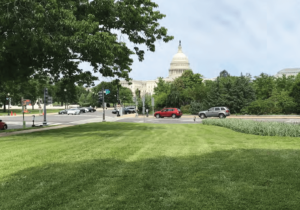Washington, D.C., boasts a wide array of memorials, from vaunted white marble presidential tempietti to the more subdued Titanic Memorial and Temperance Fountain. Lying somewhere in between is the World War I Memorial, which opened in mid-April, completing a set of sites marking U.S. involvement in the last century’s four major wars.
“The Great War touched almost every American family,” said President Joe Biden in a video recording that was played at the opening ceremony on April 16. “For too long, that nationwide service has not been fully commemorated here in the nation’s capital.”
Unlike its counterparts (those honoring the fallen in World War II and the Korean and Vietnam Wars), the World War I Memorial is not sited on or along the National Mall. Rather, it is located a few blocks northeast in Pershing Park, a stone’s throw from the White House. The $42 million project entailed reconfiguring the park, originally designed by M. Paul Friedberg and home to a popular ice-skating rink.
The country already has an official National World War I Memorial, located in Kansas City, Missouri, which was completed in 1926; an accompanying museum opened in 2006. Washington, too, has an extant 1931 memorial to citizens of the District who died in the war, in addition to Pershing Park, so named for WWI General John J. Pershing. Featuring an intricate stepped landscape, the park incorporated the American Expeditionary Forces Memorial, notable for its reddish granite walls and statue of Pershing himself. Visitors could be forgiven for overlooking the memorial, however; in the decades following its opening in 1981, Pershing Park sank into disrepair.

In 2007, the last surviving U.S. veteran of World War I, Frank Buckles, expressed dismay at the lack of a dedicated memorial in Washington. His comments prompted political efforts either to establish a new WWI memorial on the National Mall or to re-dedicate the D.C. War Memorial as a National WWI Memorial. Disputes ensued until Congress finally settled on a third option to rehabilitate Pershing Park.
Following a 2015 competition garnering more than 350 submissions, the World War I Centennial Commission selected five finalist proposals, eventually whittling these down to The Weight of Sacrifice in January 2016. The proposal, designed by architect Joe Weishaar with sculptor Sabin Howard, grew into a collaboration with architects-of-record GWWO and the Philadelphia-based David Rubin Land Collective as landscape architect, resulting in the new memorial through years of iterative agency review and adjustment. The partnership also yielded a more empathetic approach to the site and its visitors, harmonizing the new memorial with the existing park while distinguishing programmatic elements within each.
Friedberg’s large water feature—an urban oasis sheltered by berms and a stone stepwell—was used for ice skating in winter months following its opening, but poor construction and detailing made it difficult to maintain, which brought about its eventual deterioration and subsequent disuse. Weishaar et al have partially filled it in with a viewing platform but retained many aspects of the original site plan. “We want to recapture some of the energy the park had when it was first completed,” Weishaar told AN in 2019. (Friedberg nonetheless voiced opposition to the changes during the review process, calling the memorial design a disaster for its destruction of the park.)
A giant 60-foot-long frieze has taken the place of a former pump room and Zamboni garage on the site’s western edge, though its dramatic statuary figures have yet to be installed. (A canvas stands in to give visitors a sense for the work, which will be completed in 2024.) Accessible pathways have been widened, and handrails replaced. The circular footprint of Friedberg’s kiosk has been retained in a belvedere with didactic information about the memorial, offering a slightly elevated outlook over the rest of the park. A depleted tree canopy and ground cover has been fleshed out into a fuller plant palette, especially on the site’s southern and western sides to offer a better buffer between city and memorial.
The approach the design team took was one that sought to mitigate adverse effects brought forward by preservationists while creating a new expression of remembrance within the site: “We could redefine its accessibility throughout,” David Rubin recalled in a recent lecture at the National Building Museum. “We could manage the change in such a way that the memorial of Pershing, which existed, would shine even more true, but the park itself would be reflective of Paul Friedberg’s aspirations, [in] that it would receive the memorial as part of its overlay where both could be read.”
Perhaps most crucially, the team has also outlined a maintenance plan with the National Park Service, ensuring that this iteration of Pershing Park gets the necessary upkeep to endure.











